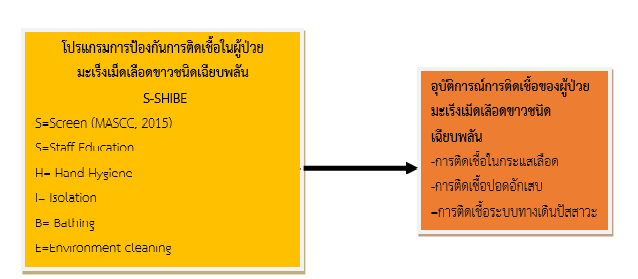Effectiveness of an Infectious Prevention Program for Patients with Acute Leukemia in Hematology-Oncology Medicine Ward at Surat Thani Hospital
Keywords:
Infectious Prevention Program, Acute LeukemiaAbstract
Infection in patients with acute leukemia tends to be increasing. The infectious prevention is therefore essential to ensure patient's safety. This quasi-experimental posttest- two group design research aimed to compare the infection incidence between patients with acute leukemia who received the infectious prevention program and those who received regular nursing care. Sixty patients with acute leukemia were selected using purposive sampling, and then assigned into an experimental or control group (30 subjects per group). The tool used in the experiment was the infection prevention program for patients with acute leukemia, including assessment of risk factors for febrile neutropenia, health education, hand washing, patient isolation, cleansing the patient's body with 4% Chlorhexidine soap, and environmental cleaning. The tool used was a hospital infection surveillance record form. Its content validity was verified by a panel of three experts. Data were analyzed using percentage, mean, standard deviation, and odds ratio.
Results of research revealed that the incidence of sepsis in the control group and the experimental group was not different (Odds ratio = 0.38, 95% CI: 0.12 - 1.20, p-value= 0.079). The likelihood of having infected pneumonia was not different between the control group and the experimental group (Odds ratio= 0.62, 95% CI: 0.16 - 2.45, p-value= 0.365). However, the likelihood of having urinary tract infection in the control group was significantly higher than in the experimental group (Odds ratio = 0.17, 95% CI: 0.02 - 1.58, p-value = 0.097).
Per findings, the program can be applied to prevent urinary tract infection in patients with acute leukemia in similar contexts.
References
Centers for Disease Control and Prevention. (2013). Blood cancers: Leukemia, lymphoma, and a myeloma. Nontaburi. (in Thai)
Center for Disease Control and Prevention. (2015). Facility guidance for control hospital associated hospital. Retrieved September 15, 2020 from https://www.cdc.gov. (in Thai)
Freifeld, A., Bow, E., & Sepkowitz, K. (2011). Clinical practice guideline for the use of antimicrobial agents in neutropenic patients with cancer: 2010 update by the infectious diseases society of America. Clinical Infectious Diseases, 75(12), 52:e56–93.
Infectious Disease Association Thailand. (2019). Identifying healthcare - associated infections (HAI) for NHSN surveillance. Bangkok: Aksorn Graphic and Design Publishing. (in Thai)
Kosol, S. (2021). Development of a carbapenem resistance enterobacteriaceae spread prevention model in hematology and oncology medicine ward, Surat Thani hospital. Institute for urban disease control and prevention journal, 5(2), 101-115.
Kovitangkoon, K., Putthanachote, N., Sangsa, N., Kaewmafai, J., & Sarakran, P. (2017). Factors associated with bacterial septicemia among patients in intensive care unit, Roi Et. hospital, Roi Et province. Srinagarind Medical Journal, 32(2), 111-118.
Lekdamrongku, P. (2015). Nursing management and assessment of febrile neutropenia (FN) risks in cancer patients treated with chemotherapy: The role of nurses. Thai Journal of Nursing Council, 30(1), 5-15.
Malathum, K. & Rongrungruang, Y. (2017). Prevention and control in healthcare setting. Bangkok: Aksorn Graphic and Design Publishing. (in Thai)
Pattanpongdilok, C. (2015). The guideline for interdisciplinary operation to support a victim of virulence in family at one stop crisis center in Bangkok metropolitan administration hospital. A thesis submitted in partial fulfillment of the requirements for the degree of master of social work in social welfare administration and policy department of social work faculty of social administration, Thammasat University. (in Thai)
Pongstaporn, W. (2016). Childhood acute lymphoblastic leukemia. Thai Cancer Journal, 36(2), 68-75.
Prasertsri, T. & Phanthusart, N. (2018). Influence factors and severity of infections within the Cancer patient. Journal of Nursing and Health Care, 36(2), 22-30.
Reich, G., Mapara, M. Y., Reichardt, P., Dorken, B., & Maschmeyer. (2001). Infectious complication after high-dose chemotherapy and autologous stem cell transplantation: comparison between patients with lymphoma or multiple myeloma and patients with solid tumors. Bone Marrow Transplanttation, 27, 525-527.
Sharad, M. A. & Stephen, R. C. (2016). Evaluating the impact of a computerized surveillance algorithm and decision support system on sepsis mortality. Journal of the American Medical Informatics Association, 24, 88-95.
Siegel, R., Naishadham, D., & Jemal, A. (2013). Cancer statistics, 2013. A Cancer Journal for Clinicians, 63(1), 11–30.
Tangbovornveerakul, T., Bunkoe, P., Srisompoch, K., Phunprathum, C., Prakobwanichakul, N., & Techakehakij, W. (2015). The infection of febrile neutropenia in leukemia at Suratthani hospital: Incidence of infection, causative organism and factors associated with treatment outcomes. Thammasat Medical Journal, 15(1), 29-38.
Temtap, S., Hiruchunha, S., & Nilmanat, K. (2015). Development of self-care promotion among patients with Acute Myeloid Leukemia (AML) and receiving chemotherapy. The Southern College Network Journal of Nursing and Public Health, 2(3), 21-40.
The Multinational Association For Supportive care in Cancer. (2015). Identifying patients at low risk for FN complications: Development and validation of the MASCC risk index score Retrieved September 15, 2020 from https://www.mascc.org.
Thongcharoen, P., Moongtui, W., & Unahalekhaka, A. (2015). Effects of using multifaceted strategic method on practices of healthcare personnel in prevention of multidrug resistant bacterial infection. Nursing Journal, 42(1), 61-73.

Downloads
Published
How to Cite
Issue
Section
License
Copyright (c) 2021 Boromarajonani College of Nursing, Nakhon Si Thammarat

This work is licensed under a Creative Commons Attribution-NonCommercial-NoDerivatives 4.0 International License.
บทความที่ได้รับการตีพิมพ์เป็นลิขสิทธิ์ของ วิทยาลัยพยาบาลบรมราชชนนี นครศรีธรรมราช
ข้อความที่ปรากฏในบทความแต่ละเรื่องในวารสารวิชาการเล่มนี้เป็นความคิดเห็นส่วนตัวของผู้เขียนแต่ละท่านไม่เกี่ยวข้องกับวิทยาลัยพยาบาลบรมราชชนนี นครศรีธรรมราช และบุคคลากรท่านอื่น ๆ ในวิทยาลัยฯ แต่อย่างใด ความรับผิดชอบองค์ประกอบทั้งหมดของบทความแต่ละเรื่องเป็นของผู้เขียนแต่ละท่าน หากมีความผิดพลาดใดๆ ผู้เขียนแต่ละท่านจะรับผิดชอบบทความของตนเองแต่ผู้เดียว




